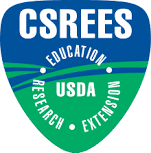Extension provides non-formal education and learning activities to people throughout the country — to farmers and other residents of rural communities as well as to people living in urban areas. It emphasizes taking knowledge gained through research and education and bringing it directly to the people to create positive changes.
All universities engage in research and teaching, but the nation’s more than 100 land-grant colleges and universities have a third, critical mission — extension. Through extension, land-grant colleges and universities bring vital, practical information to agricultural producers, small business owners, consumers, families, and young people.
NIFA supports both universities and local offices of the Cooperative Extension System (CES) to provide research-based information to its range of audiences. As the CES federal partner, NIFA plays a key role in the mission by distributing annual congressionally appropriated formula grants to supplement state and county funds.
IMPROVING LIVES IN RURAL AND URBAN AREAS
The hallmarks of the extension program — openness, accessibility, and service — illuminate how cooperative extension brings evidence-based science and modern technologies to farmers, consumers, and families. Through extension, land-grant institutions reach out to offer their resources to address public needs. By educating farmers on business operations and on modern agricultural science and technologies, extension contributes to the success of countless farms, ranches, and rural business. Further, these services improve the lives of consumers and families through nutrition education, food safety training, and youth leadership development.
PAST, PRESENT, AND FUTURE
In 2014, NIFA and our land-grant university partners celebrated 100 years of Cooperative Extension in the United States. The Smith-Lever Act formalized extension in 1914, but its roots go back to agricultural clubs and societies of the early 1800s. The act expanded USDA’s partnership with land-grant universities to apply research and provide education in agriculture. Over the last century, extension has adapted to changing times and landscapes, and it continues to address a wide range of human, plant, and animal needs in both urban and rural areas. Today, extension works to:
- Translate science for practical application
- Identify emerging research questions, find answers and encourage application of science and technology to improve agricultural, economic, and social conditions
- Prepare people to break the cycle of poverty, encourage healthful lifestyles, and prepare youth for responsible adulthood
- Provide rapid response regarding disasters and emergencies
- Connect people to information and assistance available online through eXtension.org (link is external)
The nation’s transformation from a manufacturing to an information society raises questions as to how to best reach an intended audience. Extension educators use modern technology to disseminate knowledge and tools but also rely on traditional human values and relationships to gain the attention and trust from the people they serve. As residents of the communities in which they work, local extension agents bring credibility to their roles as educators.
HIGH-IMPACT OUTCOME
TOMORROW’S AGRICULTURAL AND NATURAL RESOURCE WORKFORCE
Experiential learning is a great way to promote youth interest in adopting science, technology, engineering, and mathematics (STEM) in their future careers. NIFA-supported 4-H programs touch over 6 million children across the country every year. Several projects supported by NIFA Smith-Lever funds and special funding from the U.S. Fish and Wildlife Service taught youth to learn and apply Geographic Information Systems mapping skills that support wildlife refuge systems from the Caribbean to the Pacific, Maine to Alaska. For example, youth in Iowa tested the effectiveness of mapping using iPhones compared with Global Positioning System units. This learning experience allowed them to map features such as fences, invasive species, oak stands, and areas that need attention to conserve wildlife. Similarly, a project in Minnesota engaged teens on the White Earth Indian Reservation to conduct golden-winged warbler habitat and nesting cover mapping at the Tamarac Refuge. Such experiences help youth develop science skills and learn skills necessary for future employment.
Error: Contact form not found.
Is this your initiative?
Claiming allows you to manage your initiative.






